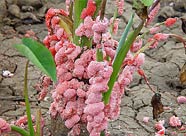Apple Snail
 Apple snail (Pomacea canaliculata, Pomacea bridgesi, Pomacea paludosa, and Pila conica)
Apple snail (Pomacea canaliculata, Pomacea bridgesi, Pomacea paludosa, and Pila conica)
Ampullariidae
Description:
- Freshwater snail with a rounded, yellowish to dark brown shell.
- Can reach the size of an apple, but in Hawaii they tend to be slightly smaller than a golfball.
- Lives in tropical areas, in slow-moving fresh water including rice and taro growing areas, ponds, ditches, wetlands and slow-moving streams.
- Native to South America, believed to have been introduced as a food crop, although also available in aquarium stores. apple snails bought in aquarium stores then released for culture as food items, appears to have been one reason for the spread of Pomacea canaliculata in Hawaii. Pomacea canaliculata first reported on Maui in 1989. Pila conicareported in Hawaii in 1966.
Harm:
- Apple snails damage taro plants by chewing into the corm at the very top of the taro plant, which leaves a hole through which bacteria and other pathogens to enter. Damage either kills the plant or drastically reduces crop quality and yield. apple snails also eat the young shoots of taro. Damage to other water-based crops such as rice occurs in similar fashion.
- Snails in natural systems eat plants that provide food or habitat for native fish and birds.
- Snails can carry and transmit rat lungworm (Angiostrongylus cantonensis), when improperly cooked and eaten, causing fever or death in extreme cases. Also a known vector for blood flukes (Schistosoma spp.) and an intestinal flukes (Echinostoma ilocanum).
- The snails were introduced (sometimes without permission) and quickly became pests in Indonesia, Thailand, Cambodia, Hong Kong, southern China, Japan, Guam and New Guinea. In the Philippines, they became the top pest in rice fields, where there has been 100% crop loss heavily infested areas.
- Although economic loss due to apple snails is significant, comprehensive studies have not yet been conducted.
In Hawaii:
- Pomacea canaliculata present on all islands except Molokai and Lanai. Some infestations are extremely heavy, including Hanalei on Kauai, Keanae on Maui, and Waipio Valley on Hawaii. Pila conica present on Molokai.
- Control by hand-picking and use of Cayuga ducks which eat small snails.